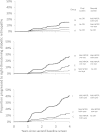A simple risk stratification for time to development of sight-threatening diabetic retinopathy
- PMID: 23150285
- PMCID: PMC3579348
- DOI: 10.2337/dc12-0625
A simple risk stratification for time to development of sight-threatening diabetic retinopathy
Abstract
Objective: The American Diabetes Association and the English NHS Diabetic Eye Screening Program recommend annual screening for diabetic retinopathy (DR) with referral to ophthalmology clinics of patients with sight-threatening DR (STDR). Using only longitudinal data from retinal photographs in the population-based NHS Diabetic Eye Screening Program in Gloucestershire, we developed a simple means to estimate risk of STDR.
Research design and methods: From 2005, 14,554 patients with no DR or mild nonproliferative DR only at two consecutive annual digital photographic screenings were categorized by the presence of DR in neither, one, or both eyes at each screening and were followed for a further median 2.8 years.
Results: Of 7,246 with no DR at either screening, 120 progressed to STDR, equivalent to an annual rate of 0.7%. Of 1,778 with no DR in either eye at first screening and in one eye at second screening, 80 progressed to STDR, equivalent to an annual rate of 1.9% and to a hazard ratio (HR) of 2.9 (95% CI 2.2-3.8) compared with those with no DR. Of 1,159 with background DR in both eyes at both screenings, 299 progressed to STDR equivalent to an annual rate of 11% and an HR of 18.2 (14.7-22.5) compared with individuals with no DR.
Conclusions: Combining the results from 2 consecutive years of photographic screening enables estimation of the risk of future development of STDR. In countries with systematic screening programs, these results could inform decisions about screening frequency.
Figures
References
-
- Diabetic Retinopathy ADA. Diabetes Care 2002;25(Suppl. 1):s90–s93
-
- Scanlon PH. The English national screening programme for sight-threatening diabetic retinopathy. J Med Screen 2008;15:1–4 - PubMed
Publication types
MeSH terms
Grants and funding
LinkOut - more resources
Full Text Sources
Medical



